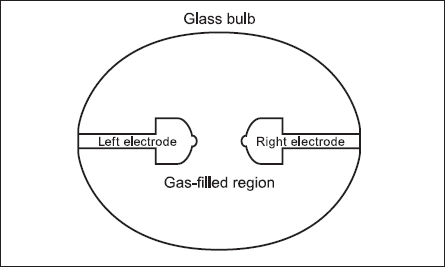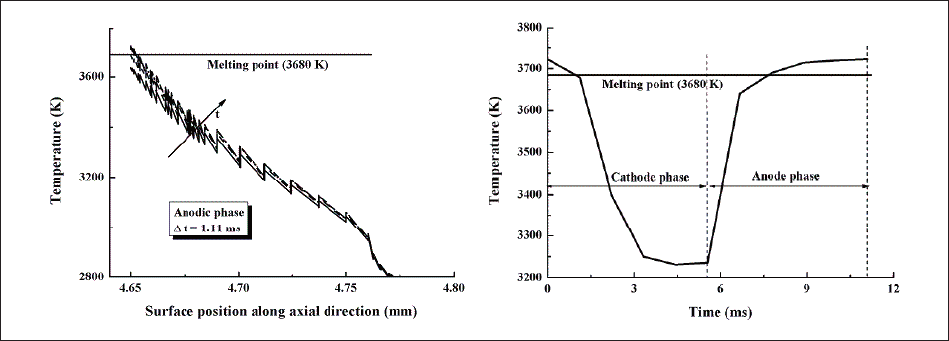光技術情報誌「ライトエッジ」No.31
2007.5 LS-11(11th Int'l Symp. on the Science and Technology of Light Sources)
(2008年10月)
Study of HID lamp by a 3-D and time-dependent model:
determination of temporal distributions
of electrode temperatures
K. C. Paul1, T. Takemura1, T. Hiramoto2, and T. Igarashi3
1R&D Center, Ushio Inc., 1-90 Komakado, Gotenba, Shizuoka 412-0038. Japan.
2R&D Center, Ushio Inc., Asahi Tokai Buld., 2-6-1 Ote-machi, Chiyoda-ku, Tokyo 100-0004, Japan.
3R&D Center, Ushio Inc., 1194 Sazuchi, Bessho-cho, Himeji, Hyogo 671-0224, Japan.
Contact : k.paul@ushio.co.jp
ABSTRACT
This article presents a three-dimensional model and its application into calculating properties of a high intensity discharge lamp operated by an alternating current. Electrodes and mercury-filled fluid region have been modelled in a single entity. Operating pressure of the very high-pressure lamp has been chosen as 10 Mpa and the peak value of the operating current has been taken as1.4 A. The current has been assumed to have a square waveform with a frequency of 90 Hz. Main attention has been given to determine the time-dependent temperature distributions of the purely-tungsten electrodes. Near the electrode-tips, temperature has been found to rise above the melting point of 3680 K. Temperature distributions are found to vary with time, especially near the tip surfaces, as well as with cathodic and anodic phases. The calculated maximum temperatures in some instants of the cathodic and anodic modes are about 3700 K for the pure tungsten-electrodes
INTRODUCTION
Very high pressure and high intensity discharge (HID)lamps are in wide applications today. These are seen from general lighting through high-tech applications. In speedy development of HID lamps, numerical modelling has been realized as a vital tool. Moreover, numerical studies provide adequate physical understandings, which in turns help in developing efficient and highly reliable lamps. This work is devoted to develop a very powerful numerical model for HID lamps. The model is prepared for considering all three directions and for giving time-dependent behaviour of an HID lamp. In developing the numerical model, we have chosen a vendor-supplied computational platform. called Fluent. The complete set that describes magnetohydrodynamics (MHD)- conservation equations of mass, momentum and energy along with the Maxwell's expressions - is solved simultaneously in the computational platform using customized modules. Vector potential form of Maxwell ’s equations is considered in our case. The 3-D and time-dependent model is applied to a lamp having ellipsoid glass bulb. Electrodes and gas-filled region of the lamp are modelled and the primary attention for this article is given to determine the temperature distributions of the electrodes during operation by an alternating current (AC). Peak value of the square-wave current is 1.4 A and the operating frequency of the lamp is 90 Hz. Operating pressure of pure mercury lamp is 10 MPa. Electrodes are considered of pure tungsten.
MODEL DESCRIPTION
The model calculates the gas-filled and electrodes regions. Schematics of the calculated domains are shown in Fig. 1. For obtaining the current density distribution at the cathodic electrode, a sheath-model[1] has been solved for lookup tables of heat flux and current density, and these tables are then used to model the cathode body by solving the energy balance equation. Having the current density distribution at the cathodic electrode known, the 3-D model has been solved for the lamp by changing electrode polarity. Detailed of the 3-D model can be seen in our recent publication[2]. In brief. gas-filed region has been modelled by solving the conservation equations of mass, momentum and energy and also by solving the vector potential form of Maxwell’s equations. Radiation transport has been modelled by discrete ordinates (DO) method for grey bands dividing the radiation spectrum between 100 and 20000 nm into 5 bands: 100-119.2nm, 119.2-350nm, 350-780nm, 780-4500nm and 4500-20000nm. Coupled boundary condition has been used at the electrode-fluid interfaces to obtain the consistent temperature distribution at the electrode surfaces. For the glass-bulb boundary, an empirical temperature distribution has been used. Temperature-dependent band absorption coefficient and emissivity have been used at the solid-fluid boundaries for solving radiation transport by the DO method.

Fig.1 : Schematics of the calculated HID lamp
RESULTS
Time-dependent solution of the mercury lamp has been done for an operating frequency of 90 Hz with a peak value of the current as 1.4 A. Temperature distributions at the electrode surface for anodic mode (top) and temporal change of electrode-tip’s maximum temperature for a cycle of operation (bottom) are presented in Fig.2. During the cycle of operation, temperature change has been profound near the tip surfaces, mainly in the regions through which current flows, but it is not significant in the regions away from the tip surface. Figure in the top presents the temperature of all nodal points in the electrode periphery for particular axial positions and it can be realized that temperature in axial cross-sections of the electrode, especially near the tip, is not the same or temperature does not have rotational symmetry even inside the metallic body. The figure in the bottom implies that temperatures are above the melting point in a couple of micrometers from the tip surface around the end of anodic mode and at the very beginning of cathodic mode. Current flow through the constricted region of the electrode tips is the primary reason for such very high temperatures around the tip surfaces. If current-flow can be made diffused over electrode surfaces, electrode temperature can be controlled to withstanding limit.

Fig.2: Time dependent electrode surface temperatures at anodic mode and maximum temperatures of a cycle
CONCLUSIONS
This article presents a robust 3-D and time-dependent model for HID lamps. It takes into account the discrete ordinates (DO) method for evaluating the radiation transport. Solution of radiation transport has been carried out by dividing the radiation spectrum between 100 and 20000 nm into 5 grey bands. Test calculations have been done for presenting the model on an ellipsoid-bulb lamp that has been assumed to operate at 10 MPa and 1.4 A peak current of 90 Hz square wave. Predicted results by this model can produce adequate information for developing an HID lamp operated by direct or alternating current. In this work, attention has been given to electrodes and the time-dependent electrode surface temperatures have been discussed elaborately. For this particular lamp geometry and operating conditions, surfaces closer to electrode tip are found to be in a very high temperature, above the melting temperature of electrode material Application of this robust 3-D and time-dependent model should expedite HID lamp developing cycle, reduce the cost and help in developing efficient and highly-reliable lamps.

